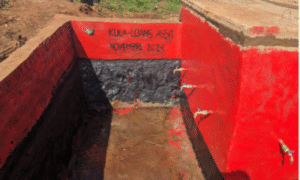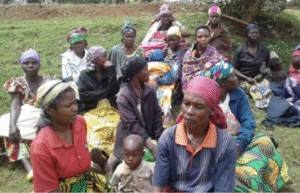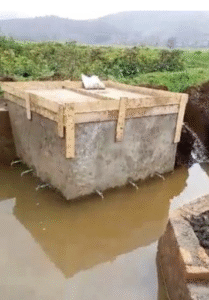By guest authors Chris Roesel and Erlijn Sie

We are on a mission to build the world’s largest decentralized, village-based clean water network — where every community owns, manages, and benefits from its own water source. We invite you to join us — as a partner, donor, or changemaker — to bring this vision to life in your community.
A Movement Rooted in Community Leadership
This initiative grows from the work of a diverse coalition of partners teaming up with communities to strengthen their well-being. These stories come from places where the need is great, but the human drive for change is greater.

In the Democratic Republic of Congo (DRC) — one of the five poorest nations in the world, where nearly 75% live on less than $2.15/day — women’s saving groups are financing their own clean water solutions. Each group of 25 women in Walungu and Kabare territories pooled $1,250 in savings from modest household incomes — raising chickens, selling eggs, or operating microenterprises. Their greatest need was simple: access to clean water.
 With support from local partner ASSIT and an additional $6,000 co-investment from Kula International, they built a six-tap water installation. The women contributed labor and oversight, while a local technician ensured water quality and system design.
With support from local partner ASSIT and an additional $6,000 co-investment from Kula International, they built a six-tap water installation. The women contributed labor and oversight, while a local technician ensured water quality and system design.
Within just four months, the system began serving 1,500 villagers. The women now own and operate the facility. Each 20-liter container sells for $0.20, with 150 buckets sold daily, generating $30/day — enough to repay their initial loan within a year and continue earning sustainable income. This model not only provides safe water but also reduces waterborne disease and builds local entrepreneurship.
A Second Story: From Cameroon’s Mountains
In Cameroon, where 23% of people live below the poverty line, the village of Nkambe built its own 20,000-liter storage tank with seven taps and five wash basins. With guidance from Ecological Balance Cameroon, the Nsa-kop community formed a water management committee to collect user fees, organize cleanups, and protect their watershed by replanting trees and fencing the catchment.

“Our water committee asked us to stop washing clothes at the tap. We carry our water home and help clean the catchment area. We all share responsibility,” said one resident. Their community now supplies 5,000 households with clean, reliable water — proving that local leadership creates lasting change.
Towards a Model for the Future: Scaling of Shared Prosperity
These community-led projects demonstrate a powerful truth: when people own their water, they own their future. Now imagine this model replicated in 1,600 communities, serving 2.8 million people living on less than $3 a day. That would equal the reach of the world’s largest centralized water plant — but achieved through self-sufficient, village-owned water enterprises that build local wealth and dignity.
The Research Behind Empowerment
Evidence supports what these women already know. In Rajasthan, India, Desai and Olofsgård (2019) found that women in villages with self-help groups were significantly better informed about solving water shortages than those without such groups.
The Practice supporting this Movement

These two examples of community-driven change, village-based clean water facilities, show a model to grow this decentralised and independent clean water plant. Three key practices support this movement. On the one hand, the vast experiences working with millions of self-help groups and saving groups around the world. Next to that, it is key that thevalue stays in the respective communities.
It illustrates how the community can build on existing solidarity and grow shared responsibility to produce water, maintain and protect the clean water installation. As long as the value, the facility as well as the benefits and revenue from the water installation, stays in their community.
Thirdly, empowering groups of village-based change agents bringing essential services and growing village economy can be a grassroot force for good. Key to this is the practice of prosumers. A prosumer is an individual that both consumes and produces. Both models encourage members from marginalized communities to not only be consumers of safe drinking water but also to be producers of this essential service.
Join the Movement!
To reach 2.8 million people, we need just 1,600 community water ventures. You can help:
• Fund the next women-led water facility ($5,000–$7,000 per village).
• Partner with a local saving group ready to invest in its own future.
• Share this model through your Rotary Club, foundation, or business network.
Together, we can build the world’s largest decentralized clean water network — village by village, well by well, woman by woman. Join us. Invest in self-reliance. Help communities own their water.
What are you waiting for?
